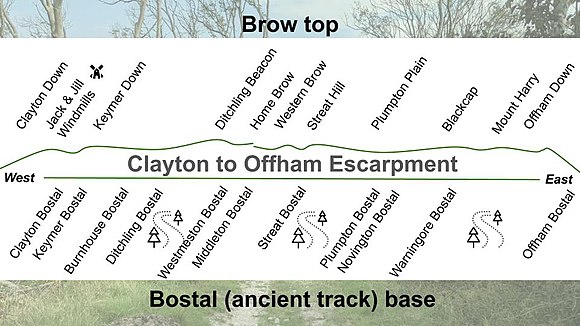Clayton to Offham Escarpment
[3] Unlike the scarp top, the steeply sloping chalk grassland of the escarpment has been spared modern farming ploughing, fertilising and spraying of herbicides.
Instead the area has been used for traditional low-level animal grazing and as a consequence the site is still pristine chalk grassland, which has created a ten kilometre stretch of wild flower meadows.
Such areas have been described as Europe's tropical rainforests and the National Trust tell us, "They're home to an incredibly rich and diverse range of plant and insect life".
[6] Beorg is also the origin of the word ‘barrow’ - the prehistoric burial mounds - because it denoted a small round, often artificial hill.
The Clayton to Offham Escarpment passes through eight parishes including Hassocks, Ditchling, Westmeston, Streat, Plumpton, East Chiltington, St John Without and Hamsey.
The scarp slope's chalk grassland embraces an ancient scrub thicket which is an archaic cornucopia of wild, self-seeded fruits.
In spring a dwarfed version of field fleawort and chalk milkwort grows on the short turf edge of the quarries.
Large bloody-nosed beetles can be found in the bedstraw, with chalk carpet moth, chalkhill blue butterflies flitting between the flowers.
The bostals (two unnamed) pass some of the best remaining chalk grasslands in East Sussex and is an important area for wildlife including now rare plants, butterflies and moths.
The chalk pit on the scarp slope, where there is limited sunlight and damp conditions on the steep ground, is famous for Bryophytes (mosses and liverworts) with over 120 having been reported here.
Chalk grassland-loving species such as Rhytidiadelphus triquetrus and Neckera crispa grow in abundance on the north-facing slopes along with Fissidens dubius, Campylium protensum, Dicranum bonjeanii and Hylocomium splendens.
Along Burnhouse Bostal, the red listed birds of high conservation concern, spotted flycatcher, bred in 2021 indicating the importance of the SSSI.
[17] In Spring, the Westmeston bostal is rich with wildflower and harbours a huge old ash pollard (TQ 340 130), which many seek out to admire.
[8] The Streat Hill bostal and scarp slope (TQ 351 130) has long been ungrazed, and as a consequence has lost much of the species-rich chalk grassland to invasive scrub.
[8] To the west of the Streat Hill is the Queen Victoria Jubilee plantation (TQ 348 130), which forms the sign of a V on the middle of the bare scarp slope.
The field opposite the Half Moon was known as the Brighton Laine according to the Tithe map of 1839, perhaps because it marked the beginning of the Downland route to the town.
[8] It has a good assemblage of Down pasture flowers and secondary woodland at the bottom is rich in species, such as bluebells and ramsons.
The cross is no longer white, but to the knowledgeable eye it is still visible due to its lighter-coloured grass and when the sun is low and the depression is in shadow it can be made out from several miles away.
At the top of Plumpton Hill and Novington Scarp there are three clusters of round barrows on this on each of the three main spurs that jut forward.
The plantation has a cool and lofty interior of tall ash, sycamore, surviving beech and occasional horse chestnut.
The fallen beech carcasses are home to many fungi including green stain, turkey tail, lemon disco, jelly rot, porcelain fungus and dryad's saddle.
It is thought that after marching from Fletching, the London troops under Simon De Montfort walked up this bostal on the dawn of the day of the Battle of Lewes.
Although it is part of an SSSI, in 1997 the farmer wished to plough much of the tractor accessible ground to grow flax, which was then attracting hefty European Union subsidies even on such protected sites.
The struggle then escalated and conservationists demonstrated, set up camp on the land and started to organize its ‘unploughing’ by turning over and refitting the sods.







